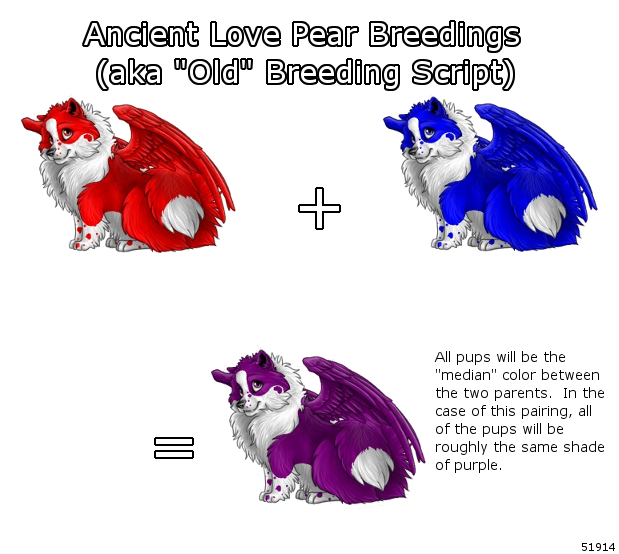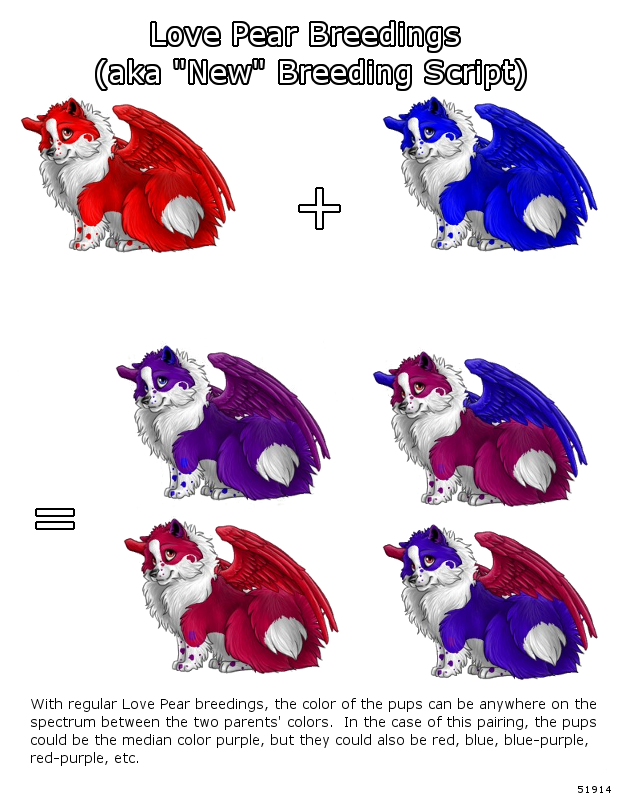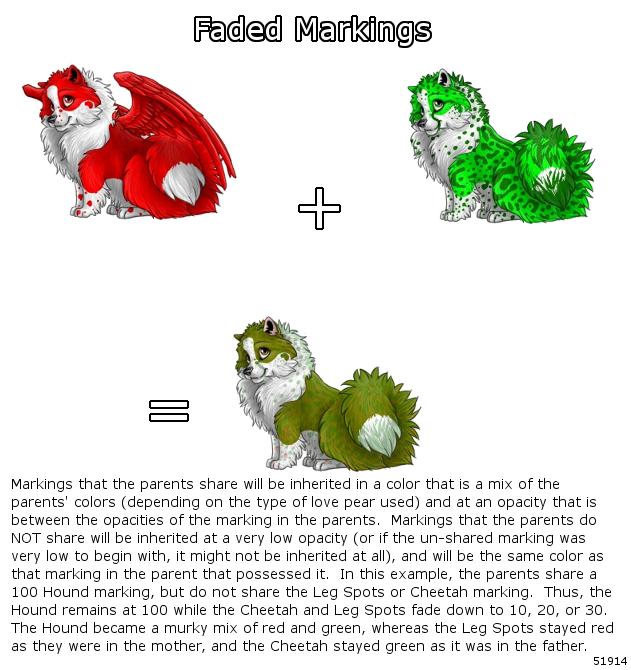Breeding Guide
The basics of breeding are very simple. In order to breed you must have two adult wajas (20+ days old) of opposite gender and either a Love Pear or Ancient Love Pear, which will be consumed at the time of breeding.
However, to breed nice looking, high quality wajas requires more thought. A lot of this will come with practice, and you will most likely make some mistakes while learning, but this guide is here to help you gain an understanding of breeding that should help you on your way to becoming an excelent breeder!
Contents
Pup Stages
Main Article: Life Cycle of a Waja
Once born, wajas will display their "Pup" image. All pups of the same breed will have the same appearance and be the same solid color from birth until they are 5 days old. At this stage you cannot see the waja's true base color, eye color, markings, or mutations on their image. Items put on waja pups will not show up. Obviously, wajas in this life stage cannot breed.
At 5 days old, the pups will become Adolescents. When their picture is refreshed, they will now display their "Teen" image, which will show their true coat color, but not their true eye color, markings, or mutations. Items put on adolescent wajas will not show up. Wajas will remain in the adolescent stage of life until they are 12 days old. Adolescent wajas cannot be bred.
When a waja reaches the age of 12 days, it becomes a "Young Adult". When their picture is refreshed, it will show their "adult" image which features their true base and eye color as well as all markings and mutations. This is the image they will have for the rest of their life. Items can now be placed on the waja and show up correctly. Wajas stay in this life stage until they are 20 days old. Young Adult wajas cannot be bred.
At 20 days old the waja is finally an Adult. It's image will not be different, but it is now finally old enough to breed. If you're impatient, you can feed an Age Pear to a pup to make it instantly reach this life stage. Adulthood is the final life stage of a waja; no matter how much older it gets it will not show signs of aging, nor will it ever die.
Remember! In order for your waja to change appearance, you must click on its picture in order to refresh it and then refresh the page to see the changes.
Love Pear or Ancient Love Pear?
You may be wondering what the difference between a Love Pear and an Ancient Love Pear is. Both can be purchased from the Pear Shop or from user shops, and both enable wajas to breed, but the appearance of the resulting pups will be vastly different depending on which pear you used.


Markings and Mutations
Marking Strength
Marking strength is represented by a number between 1 and 100. This number refers to the opacity at which the marking is set. A 100 mark will be at 100% opacity and fully opaque, whereas a 10 mark will be at 10% opacity and barely visible at all.
A waja with markings that are below 100% strength is referred to as a "Fade" if it is attractive and a "Muddy" if it is unattractive. Some users make projects out of taking a waja with faded markings and trying to breed it with other wajas until they eventually end up with an offspring with 100% markings. Other users feed a waja many markings pears, giving the waja all the Custom Markings, or as many as the user pleases. Wajas that have been given all the Custom Markings in this way are called "Pearballs". Wajas that have been given a great deal of Dye markings are dubbed "Dyeballs".
Marking Inheritance
When two wajas are bred together, the markings they share will be passed on to their pup at a strength that is between the strength of the marking in the two parents. Markings that are not shared between the two will be passed on at a low opacity, such as 20 or 30, or more rarely it won't be passed on at all. Marking strength in the pup will never be inherited at a higher opacity than its parents possessed, so there is no way to breed two wajas with a marking at 50 and get a pup whose marking is higher than 50.
The color of the marking will be determined by the color of the marking in the parents and the love pear used. If an Ancient Love Pear was used, the marking will be roughly the median color between the color of the marking in the parents. If a Love Pear was used, the marking could be any color in the spectrum between the two parents' colors. If only one parent had the marking, the pup will have the marking in roughly the same color as the parent that had the marking.
Marking opacity is inherited in increments of 10. So a waja that is born will only be able to have a marking at 10, 20, 30, 40, 50, 60, 70, 80, 90, or 100. Markings that have an opacity that is not an increment of 10 are usually the result of dyes.
The following image should help in understanding how fading of markings works.

Mutation Inheritance
Mutations are inherited according to this chart (does not factor in MU):
SHOW x SHOW: 100% of pups SHOW the mutation
SHOW x CARRY: 50% of pups SHOW, 50% CARRY
SHOW x NO: 100% of pups CARRY
CARRY x CARRY: 50% CARRY, 25% SHOW, 25% NO
CARRY x NO: 50% CARRY, 50% NO
Show means the waja has the mutation and it is visible. Carry means the mutation is not visible in the waja, but there is still a small chance of the mutation being passed to the waja's pups. No means that waja neither shows nor carries the mutation.
Mutation Gene, or MU percentage also affects how mutations are inherited. The exact formula isn't well understood, though higher MU results in higher chances of a mutation in the parent showing or carrying. It is also widely believed that you must raise the MU of both parents (even if the other parent doesn't show or carry any mutations) in order to get the best chance of getting pups to show the mutation.
Colors
Most colors on wajas behave the same as they would in mixing paint (Red x Blue = Purple, Red x Yellow = Orange, etc.). However, because we are dealing with light rather than pigment, mixing yellow and blue do not make green. Instead, this combination makes gray. For an in-depth explanation of how hex codes work, please see Hex Codes Explanation.
Color is a very important part of how a waja looks, so it's not enough to just ensure that you're breeding for strong markings; you need to also pay close attention to how two wajas' colors will blend. A very useful tool in doing this is the Color Mixer found under help on the site. Never assume that just because two wajas are pretty they will make pretty babies. Make sure to take into account not only how the base colors will mix, but also how each individual marking's colors will mix.
As stated above, the color of a marking that is shared will be a mix of the parents' marking colors, whereas the color of markings not shared will be roughly the same color as the marking in the parent that has it.
Mutations work much the same way. A mutation shared between the two wajas (whether in show or carry form) will show up in a color somewhere on the spectrum between the parents' colors. A mutation not shared in any way will show up in roughly the same color as it is in the parent who has it (if it shows up at all; see the mutations section).
Breeding Stats
There are four breeding stats:
- Litter Quantity (LQ) - This stat determines how many pups the waja will have per litter. You can raise a waja's LQ by feeding it Normal Pears.
| 0-19 LQ | 20-59 LQ | 60-89 LQ | 90-100 LQ | |
|---|---|---|---|---|
| 4 pups | 0% chance | 0% chance | 2% chance | 5% chance |
| 3 pups | 0% chance | 5% chance | 40% chance | 68% chance |
| 2 pups | 20% chance | 60% chance | 53% chance | 27% chance |
| 1 pup | 80% chance | 35% chance | 5% chance | 0% chance |
- Male Gene (MG) - This stat determines what percentage of the waja's offspring will be born male. The higher the MG, the higher the likelihood of male pups, to a maximum value of 100. You can raise a waja's MG by feeding it Male Pears.
- Mutation Gene(MU) - This affects the chance of the pups getting mutations that are shown or carried from the parents. You can raise a waja's MU by feeding it Strange Pears.
- Inbred Percentage(IN%) - Inbred percent. This is how inbred your waja is. As inbreeding is generally frowned upon for its real world implications and for being seen as lazy, wajas that are inbred are usually considered to be worth drastically less than non-inbred wajas. The site doesn't record an IN% for inbreeding that occured further back than the grandparents.
You can reduce a waja's IN % by feeding it Ice Pears. However, the waja will still technically be inbred, as you can't change its lineage.
Pup Predicting
Pup predicting can help you to know what kind of pup you're going to get before you breed, saving you time and money that could be wasted on a bad pairing. While it's difficult to predict how Ancient Love Pear breedings will turn out, it's fairly simple to predict roughly how a Love Pear breeding will come out.
- In one tab, open the Custom Demo (found under world).
- In another tab, open the Color Mixer (found under help).
- In two more tabs, open the pages of both parents.
- On the custom demo page, start putting in the markings of the mother (do not edit the color or strength of the markings yet), going from top to bottom.
- Once you've put in all the markings the mother has in the order she has them, you can now add any markings that the father does not share with the mother.
- Now we can start filling in opacities. For any marking that they share, pick roughly the average of their opacities and enter it (keeping in mind that markings are inherited in increments of 10). So if the mother had a marking at 100 and the father had the marking at 50, we're going to guess about 70.
- For any marking they don't share, set the opacity at 10, 20, or 30.
- Now, for base color, eye color, and each marking they share, enter their colors into the Color Mixer. Copy and paste the median color's code into the corresponding slot in the Custom Demo.
- If they both share a mutation, or if they both carry the mutation and you'd like to see how it might look if it shows up in the pups, do the same for the mutation.
- If one waja shows/carries a mutation but the other does not, then if it shows up it will show up in the color of the parent who has it, just like unshared markings do. However, it is unlikely it will show up unless the wajas have a high MU
- For each marking they don't share, copy and paste that marking's color from the parent who has the marking into the corresponding slot in the custom demo.
- Press "Preview".
Breeding for Profit
If you plan to breed wajas in order to sell them for a profit, there are some things for you to keep in mind.
- Lower generation wajas are generally worth more than higher generation wajas, with generation 2 and 3 being the most valuable bred wajas.
- Likewise, wajas with stronger markings tend to sell for more than wajas with weaker markings. Wajas with all 100 markings are generally considered worth much more than wajas with faded markings.
- Pay close attention to colors and how they blend when breeding to ensure you get nice looking pups.
- Remember to take into account possible mutations. If both wajas carry bat wings, there's a decent chance of the pups having them too. This can be a good or a bad thing, depending on the pair.
- Do not inbreed. Inbred wajas are worth drastically less than non-inbred wajas, and many users won't buy inbred wajas at all.
- Use dyes sparingly and tastefully. Generally, cheap shop dyes like Kitsune, Giraffe, Jester, and Heart Cape are so over-used that they will usually bring down the value of a waja, whereas expensive dyes like Cheetah and Collar will increase it.
- Likewise, use potion mutations sparingly. It is generally best to avoid adding these mutations to your waja, as many users are picky about them and the potions are cheap enough that your average user can afford to add them for themselves if they want them.
- Avoid over-done marking combos, such as cheetah/belly, husky/ocelot, husky/wind, etc. Most users will already own a waja like this and won't be interested in buying more like it.
- Start a sales thread on the Waja Sales board on the forums. Post pictures and links to the wajas you're trying to sell. If you don't know how to post links or pictures, check out the HTML page to learn how.
- The Pricing Wajas page has good tips on how to price the wajas you plan to sell.
Releasing
During your adventures in the world of breeding wajas, you're likely to make some mistakes. If you breed a waja that is unattractive and you do not want it for yourself, or if you bred two wajas by accident and they turned out inbred, it's best to release the resulting offspring to live with the Obsessed Waja Fan rather than trying to sell them. This frees up space in the server for new, wanted wajas to be created and keeps the waja search clean.
Common Terms Used in Breeding
- LQ: Litter Quantity. Can be increased by using Normal Pears. Litter Quantity increases the chance of how many pups are born in one litter (up to 4 per litter).
- MG: Male Gene. Can be increased with Male Pears. MG increases the chance of males being born in the litter.
- MU: Mutation Gene. This can be increased by using Strange Pears. It increases the chances of mutations being passed down to pups.
- In%: Inbred Percentage. Shows how inbred a waja is. The site only counts inbreeding if it occured within the last two generations. Can be reduced using Ice Pears (though the waja is still inbred, as you can't change its lineage).
- IBP: Instant Birth Pear. When fed to a pregnant waja, she will instantly give birth. Very expensive item.
- LP: Love Pear. Used to breed Wajas. Owner of the female supplies this.
- ALP: Ancient Love Pear. Used to breed Wajas with the old breeding script. Owner of the female supplies this.
- Studs / Studding: This is the term used for male wajas that are available for breeding, usually for a fee.
- Reverse Breeding: Also known as RB. This term refers to a female waja that is available for breeding, usually for a fee. These are usually more expensive than studs as the waja will be out of commission for 5 days while carrying your pups.
- Breed Dominance: When breeding two wajas of different breeds, breed dominance determines how likely you are to get one breed or the other in the pups.